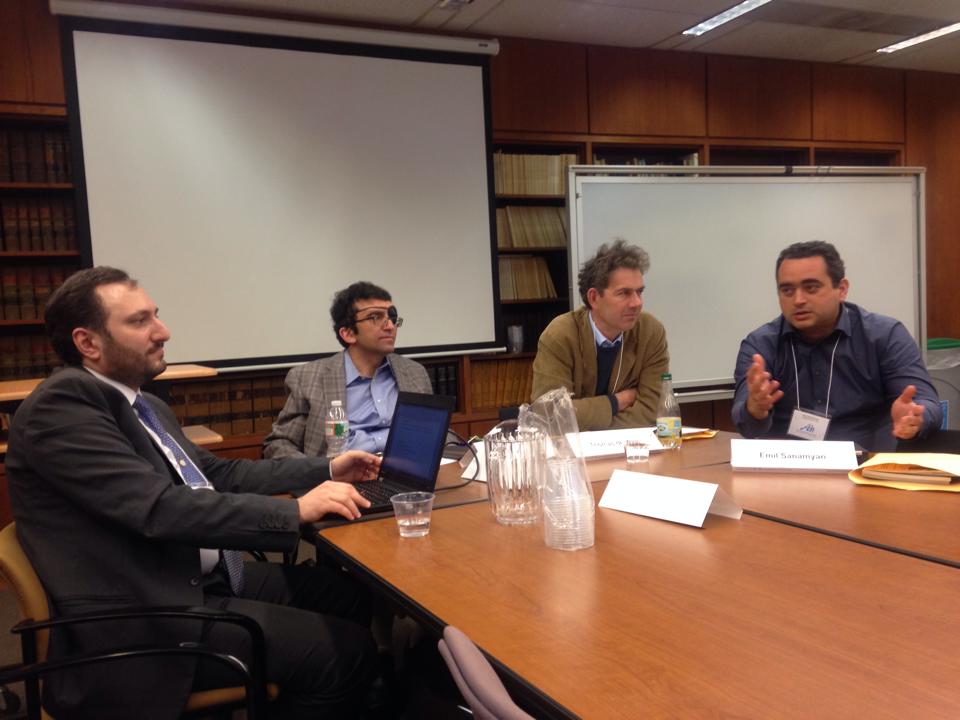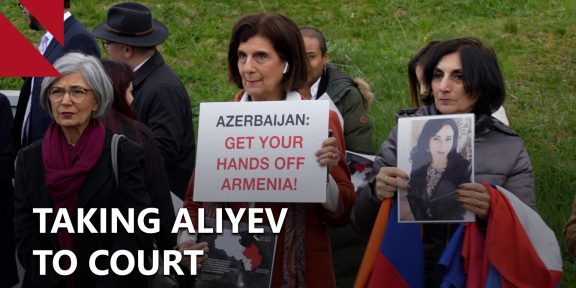University of Southern California Institute of Armenia Studies held a Q&A session with Senior Fellow of Carnegie Europe, Thomas de Waal, on the Armenia-Azerbaijan status quo. The author of “Black Garden” and “The Caucasus: An Introduction,” De Waal (TW) answered questions put to him by the Focus on Karabakh editor, Emil Sanamyan (ES).
ES: In your latest analysis you made a point that when it comes to the Karabakh conflict today the focus should be on ‘incremental change’. What kind of incremental change do you have in mind?
TW: Let me begin to answer that by saying how difficult I think incremental change is to bring about in the Karabakh context. Most experts on conflict would say that conflicts generally don’t get resolved with a stroke of the pen and a flash of lightning. Instead they are gradually transformed over years from a position of antagonism by various steps and concessions to a situation where the parties no longer feel threatened by one another and an environment of peace eventually replaces one of war. We’ve seen that happen in Northern Ireland, although it is not 100 percent complete. Likewise, Cyprus is on that path. It’s now in a very different and much better place than it was 20 years ago, thanks to confidence-building measures such as the opening of the Green Line in 2003.
So in an ideal world it would be good to see a step-by-step solution to the Karabakh conflict through mutual concessions, such as the Armenian side relinquishing one of the districts south-east of Karabakh in return for the re-opening of transport communications or the granting of greater rights to the Karabakh Armenians. But I am not so naïve as to believe that is possible right now. The dispute has become heavily “securitized” as the political scientists say, and any concessions of that kind are seen on both sides as a kind of betrayal or undermining of national security interests.
So when I say incremental change I am talking about smaller steps than that: a strengthening of the ceasefire mandate and withdrawal of heavy weapons from the Line of Contact (an Armenian demand) accompanied by the start of some more substantial political negotiations in a more structured format (an Azerbaijani demand). That give-and-take of course was the sort of deal agreed last May in Vienna and it needs to be the basis for lessening tensions now.
 ES: When it comes to the Armenian side, you mentioned recently that more should be done to appreciate the Azerbaijani pain over the outcome of the war, including the lost territories. What could the Armenian side realistically do to that effect?
ES: When it comes to the Armenian side, you mentioned recently that more should be done to appreciate the Azerbaijani pain over the outcome of the war, including the lost territories. What could the Armenian side realistically do to that effect?
TW: Well again I am talking about ideal scenarios here and not with any great expectation that anything is possible right now. But I do believe that the conflict dynamic around Karabakh and much of the Azerbaijani bellicose rhetoric is driven by the fact that much of the Armenian side seems content with the status quo and that status quo means that large parts of internationally recognized Azerbaijani territory which were home to more than half a million people (I am not talking about Nagorny Karabakh itself here) remain under Armenian control, and are still in a state of devastation. Armenians need to remind themselves (and tell the world they understand) that their quarrel is not with those people, who lost their homes and deserve to be able to return them.
Periodic reminders from the Armenian side that this land is being held as a buffer zone and something to be traded in the negotiations in return for a desired status for the Karabakh Armenians would give a bit of hope to those Azerbaijanis who long to return home and persuade them that they should be invested in a peace process, not preparing for a war. I know President Sargsyan commented once that “Aghdam is not a part of the [Armenian] homeland” and was criticized for that. But actually he was saying a right and brave thing.
I suppose my bigger point here is that it’s hard to solve or transform a conflict unless you can begin to feel empathy for the other side, unless you can say “We suffered and you suffered, we need to find a way to work together to bring to this end.” I don’t see any empathy of that kind on either side of the conflict right now. It’s not that Armenians and Azerbaijanis aren’t capable of it, they aren’t being given any space or permission to imagine empathy for the other side.
ES: What do you think it would take for the Aliyev regime to moderate its position when it comes to the conflict, and particularly to the Track II dialogue?
TW: Good question. President Aliyev is capable of making extremely aggressive remarks on the Karabakh issue—although not as aggressive as those of his defense minister. Aggressive patriotic talk is cheap and it distracts the public from other issues. I think that Ilham Aliev’s heart is a bit more in it than his father’s was, but we should also say that Aliev junior is not diehard Azerbaijani nationalist. He is from a Soviet elite Russian-speaking caste, he spent most of his youth in Moscow and will have known many Armenians from that time.
I also think that his calculation—and let’s not just talk about him, let’s talk about the collective elite in Azerbaijan–can change if the circumstances change. They can stop talking war and start talking more constructively. What circumstances could those be? I think primarily a serious political process where some real change on the ground, such as return of territories, is in prospect. A scenario where the president of Azerbaijan could see there was a real chance of getting districts back and wanted to sell that deal to his people. Then the incentive structure would change and it would make sense to talk peace and cooperation, to support Track II initiatives and to work together with the Armenians on a deal, not against them.
Of course the above applies just as much to the Armenian side. The language may not be so aggressive but the posture there is just as black-and-white. And do I see much prospect of that kind of change of climate? Well, obviously, I don’t at the moment.
ES: At this point, what are the constituencies for peace among Armenians and Azerbaijanis, whether in their homelands or diasporas? The Azerbaijani diaspora is now fairly large, do you see opportunities for engagement in that sense? Of what kind?
DW: I think there are plenty of constituencies for peace, including, as I say sometimes jokingly, somewhere in the heads of the same people who talk about war. Sometimes you find that the person who is talking about reconquering Karabakh by force also fondly remembers his Armenian grandmother. Both things co-exist in the same head… Everyone knows that, eventually, Armenians and Azerbaijanis need to live together on the map and share the same geographic space, that it will be beneficial for roads and railways to reopen, people to meet and talk and trade again. They just happen to live in the kind of world where saying that kind of thing out loud gets you nowhere or gets you into trouble.
Currently the main place you hear that message is in Georgia, where the Armenian and Azerbaijani communities still co-exist pretty well together and there are still a few mixed villages where both nationalities live side by side. I visited one of those villages, Khojorni, a few years ago and everyone was on good terms with their neighbors. But these are on the whole fairly poor villagers in remote parts of Georgia who don’t have much influence—plus there’s the problem that younger people in Georgia in particular are getting more politicized in a bad sense, something we saw during the Four Day last year. But there is a resource there. And Georgia also still provides some marketplaces and venues where Armenians and Azerbaijanis can do business together.
But let’s be honest about this. There are many people outside the South Caucasus who see the rationale of working for peace—another example is the many Armenians and Azerbaijanis who work together in Russia—but the “weather” is set on the ground and there it is getting stormier.
ES: Speaking in Yerevan, the U.S. interim negotiator Richard Hoagland justified the co-chairs’ equivocal statements to events in and around Karabakh by the need to remain an acceptable mediator for both sides. Does that make sense to you? It seems, over the years the Azerbaijani government has been ‘pushing the envelope’ on the issue and without push back, opportunities for violence and bad outcomes only increase.
TW: I understand where Armenians’ annoyance on this issue comes from. Overall—not always but most of the time—the Armenian side has an interest in strengthening the ceasefire regime, while the Azerbaijani side has an interest in shaking the status quo and military pressure is just about the only leverage it has. Which means that more ceasefire violations come from the Azerbaijani side. And as you say, you don’t get that message from the mediators.
Earlier this year, the co-chairs did single out Azerbaijan for criticism. But most of the time their statements are indeed pretty bland. And yet, I can’t blame them either. You need 100 percent proof to blame one party in a conflict for an incident, and if you do so, people will also ask “Now what? So what is your sanction?” Besides, in its own quiet way, the Armenian side does things that also undermine the peace process, such as building of roads in Kelbajar district or giving Azerbaijani settlements Armenian names. This is a game where both sides push the envelope where and when they can, and statements from the co-chairs aren’t going to stop them so easily. What’s going to stop them is a changed environment where they realize that it’s worth working on something constructive.
Right now both sides are still playing the game of trying to advance their positions vis-à-vis one another—military, diplomatic, economic positions, you name it—a few inches from time to time. And if there is no push back they will keep on inching forward—and sooner or later end up head to head again.
















